第一章:Set 接口(⭐)
1.1 概述
- Collection 接口是 List、Set 接口的父接口,该接口中定义的方法既可以用于操作 List 集合,也可以用于操作 Set 集合。
提醒
JDK 不提供此接口的任何直接实现,而是提供更具体的子接口(如:List 、Set 等)实现。
提醒
- List 系列集合的特点:添加的元素是有序、可重复、有索引。
有序,即:存取元素的顺序一致。重复,即:集合中的元素可以重复。有索引,即:提供获取索引的方法(可以使用普通的 for 循环遍历,也可以通过索引来获取元素)。
- Set 系列集合的特点:添加的元素是无序、不重复、无索引。
无序,即:存取元素的顺序不一致。不重复,即:集合中的元素不能重复(可以利用这个特性去除重复元素)。无索引,即:没有提供获取索引的方法(不能使用普通的 for 循环遍历,也不能通过索引来获取元素)。
1.2 Set 系列集合的实现类
- Set 系列集合的类继承体系,如下所示:
- Set 系列集合的实现类的特点:
- ① HashSet:无序、不重复、无索引。
- ② LinkedHashSet:
有序、不重复、无索引。 - ③ TreeSet:
可排序、不重复、无索引。
1.3 常用 API
- 由于
Set接口继承Collection接口,Set系列集合的API和Collection接口保持一致。
| Set 接口常用 API 功能描述 | API 方法签名 |
|---|---|
| 添加元素 | boolean add(E e);boolean addAll(Collection<? extends E> c); |
| 删除元素 | boolean remove(Object o);boolean removeAll(Collection<?> c);default boolean removeIf(Predicate<? super E> filter) {} |
| 清空集合 | void clear(); |
| 判断 | boolean isEmpty();boolean contains(Object o);boolean containsAll(Collection<?> c); |
| 获取集合中元素的个数 | int size(); |
| 交集 | boolean retainAll(Collection<?> c); |
| 转数组 | Object[] toArray();<T> T[] toArray(T[] a);default <T> T[] toArray(IntFunction<T[]> generator) {} |
| 遍历方式 | 迭代器遍历增强 for 遍历Lambda 表达式遍历 |
提醒
- ① 当我们向 Set 系列集合添加元素的时候,如果要添加的元素在集合中不存在,方法返回 true ,表示添加成功。
- ② 如果要添加的元素在集合中已经存在,方法返回 false,表示添加失败,因为 Set 系列集合是不允许元素重复的。
- ③ 在实际开发中,我们通常不会关心
add()方法或addAll()方法的返回值。
- 示例:迭代器遍历
java
package com.github.collection3;
import java.util.HashSet;
import java.util.Iterator;
import java.util.Set;
public class Test {
public static void main(String[] args) {
// 创建一个 Set 集合对象
Set<Integer> set = new HashSet<>();
// 向集合中添加元素
set.add(1);
set.add(2);
set.add(3);
set.add(1);
// 遍历集合
Iterator<Integer> it = set.iterator();
while (it.hasNext()) {
int num = it.next();
System.out.println(num);
}
}
}1
2
3
4
5
6
7
8
9
10
11
12
13
14
15
16
17
18
19
20
21
22
23
2
3
4
5
6
7
8
9
10
11
12
13
14
15
16
17
18
19
20
21
22
23
txt
1
2
31
2
3
2
3
- 示例:增强 for 遍历
java
package com.github.collection3;
import java.util.HashSet;
import java.util.Set;
public class Test {
public static void main(String[] args) {
// 创建一个 Set 集合对象
Set<Integer> set = new HashSet<>();
// 向集合中添加元素
set.add(1);
set.add(2);
set.add(3);
set.add(1);
// 遍历集合
for (int num : set) {
System.out.println(num);
}
}
}1
2
3
4
5
6
7
8
9
10
11
12
13
14
15
16
17
18
19
20
2
3
4
5
6
7
8
9
10
11
12
13
14
15
16
17
18
19
20
txt
1
2
31
2
3
2
3
- 示例:Lambda 表达式遍历
java
package com.github.collection3;
import java.util.HashSet;
import java.util.Set;
public class Test {
public static void main(String[] args) {
// 创建一个 Set 集合对象
Set<Integer> set = new HashSet<>();
// 向集合中添加元素
set.add(1);
set.add(2);
set.add(3);
set.add(1);
// 遍历集合
set.forEach(System.out::println);
}
}1
2
3
4
5
6
7
8
9
10
11
12
13
14
15
16
17
18
2
3
4
5
6
7
8
9
10
11
12
13
14
15
16
17
18
txt
1
2
31
2
3
2
3
第二章:HashSet 和 LinkedHashSet(⭐)
2.1 HashSet
2.1.1 概述
- HashSet 是 Set 接口的典型实现,大多数时候使用 Set 集合的时候都使用这个实现类。
- HashSet 底层原理:
- ① HashSet 集合底层采取的是
哈希表来存储数据的。 - ② 哈希表是一种对于增删改查的性能都非常好的数据结构。
- ① HashSet 集合底层采取的是
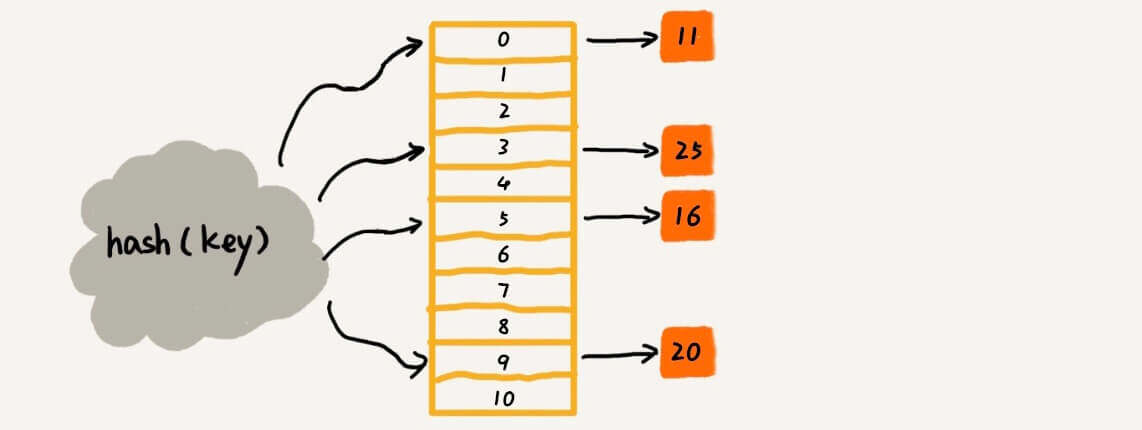
- 哈希表的组成:
- ① JDK8 之前:
数组+链表。 - ② JDK8 之后:
数组+链表+红黑树。
- ① JDK8 之前:
2.1.2 哈希值
2.1.2.1 概述
- 在
哈希表中有一个非常重要的值叫做哈希值,其是哈希表中的灵魂所在。
提醒
- ①
哈希值是数据(对象)的整数表现形式!!! - ② 在 Java 中,集合存储的数据(元素)都是对象(引用数据类型)。
- 哈希表的底层就是数组,如下所示:
- 当我们要添加一个数据,它不是从 0 索引开始依次往后进行存储的,而是通过公式计算出该数据(对象)在数组中索引:
提醒
计算数据(对象)在数组中存储位置(索引)的公式:int index = (数组长度 -1) & 哈希值。
- 既然是根据下面的公式,计算出数据(对象)在数组中的索引:
txt
int index = (数组长度 -1) & 哈希值1
提醒
- ① 我们需要将
数据(对象)变为整数(哈希值),这样上面的等式才能成立!!!
- 在 Java 中,
哈希值是通过hashCode()方法计算出来的 int 类型的数据。而 Java 中的顶级父类 Object 类就有该方法的具体实现,如下所示:
java
package java.lang;
public class Object {
// 计算对象的 hashCode,返回值是 int 类型
public native int hashCode();
...
}1
2
3
4
5
6
7
8
9
2
3
4
5
6
7
8
9
提醒
- ① 默认情况下,hashCode() 方法返回的是对象的地址值。
- ② 在实际开发中,我们经常需要重写 hashCode() 方法,利用对象内部的属性来计算哈希值。
2.1.2.2 特点
- ① 如果没有重写 hashCode() 方法,不同的对象计算出来的
哈希值是不同的。
java
package com.github.collection3;
public class Student {
private Integer id;
private String name;
private Integer age;
public Student(Integer id, String name, Integer age) {
this.id = id;
this.name = name;
this.age = age;
}
public Integer getId() {
return id;
}
public void setId(Integer id) {
this.id = id;
}
public String getName() {
return name;
}
public void setName(String name) {
this.name = name;
}
public Integer getAge() {
return age;
}
public void setAge(Integer age) {
this.age = age;
}
@Override
public String toString() {
return "Student{" +
"id=" + id +
", name='" + name + '\'' +
", age=" + age +
'}';
}
}1
2
3
4
5
6
7
8
9
10
11
12
13
14
15
16
17
18
19
20
21
22
23
24
25
26
27
28
29
30
31
32
33
34
35
36
37
38
39
40
41
42
43
44
45
46
2
3
4
5
6
7
8
9
10
11
12
13
14
15
16
17
18
19
20
21
22
23
24
25
26
27
28
29
30
31
32
33
34
35
36
37
38
39
40
41
42
43
44
45
46
java
package com.github.collection3;
public class Test {
public static void main(String[] args) {
Student s1 = new Student(1, "张三", 18);
Student s2 = new Student(1, "张三", 18);
System.out.println(s1.hashCode()); // 990368553
System.out.println(s2.hashCode()); // 1096979270
System.out.println(s1.hashCode() == s2.hashCode()); // false
}
}1
2
3
4
5
6
7
8
9
10
11
12
2
3
4
5
6
7
8
9
10
11
12
- ② 如果已经重写 hashCode() 方法,不同的对象,只要属性值相同,计算出来的
哈希值就应该是一样的。
java
package com.github.collection3;
import java.util.Objects;
public class Student {
private Integer id;
private String name;
private Integer age;
public Student(Integer id, String name, Integer age) {
this.id = id;
this.name = name;
this.age = age;
}
public Integer getId() {
return id;
}
public void setId(Integer id) {
this.id = id;
}
public String getName() {
return name;
}
public void setName(String name) {
this.name = name;
}
public Integer getAge() {
return age;
}
public void setAge(Integer age) {
this.age = age;
}
@Override
public boolean equals(Object o) {
if (o == null || getClass() != o.getClass()) return false;
Student student = (Student) o;
return Objects.equals(getId(), student.getId())
&& Objects.equals(getName(), student.getName())
&& Objects.equals(getAge(), student.getAge());
}
@Override
public int hashCode() {
return Objects.hash(getId(), getName(), getAge());
}
@Override
public String toString() {
return "Student{" +
"id=" + id +
", name='" + name + '\'' +
", age=" + age +
'}';
}
}1
2
3
4
5
6
7
8
9
10
11
12
13
14
15
16
17
18
19
20
21
22
23
24
25
26
27
28
29
30
31
32
33
34
35
36
37
38
39
40
41
42
43
44
45
46
47
48
49
50
51
52
53
54
55
56
57
58
59
60
61
62
2
3
4
5
6
7
8
9
10
11
12
13
14
15
16
17
18
19
20
21
22
23
24
25
26
27
28
29
30
31
32
33
34
35
36
37
38
39
40
41
42
43
44
45
46
47
48
49
50
51
52
53
54
55
56
57
58
59
60
61
62
java
package com.github.collection3;
public class Test {
public static void main(String[] args) {
Student s1 = new Student(1, "张三", 18);
Student s2 = new Student(1, "张三", 18);
System.out.println(s1.hashCode()); // 24052329
System.out.println(s2.hashCode()); // 24052329
System.out.println(s1.hashCode() == s2.hashCode()); // true
}
}1
2
3
4
5
6
7
8
9
10
11
12
2
3
4
5
6
7
8
9
10
11
12
- ③ 在小概率情况下,不同属性值或者不同地址值计算出来的哈希值可能一样(哈希碰撞)。
提醒
- ① 在 Java 中,int 的取值范围是
[-2³¹,2³¹ - 1],即:-21亿 ~ +21亿。 - ② 如果我在 Java 中创建 50 亿个对象,那么至少有 8 亿对象的哈希值是一样的,即:
50-(21-(-21))=8亿。 - ③ 哈希碰撞有可能发生,但是几率不高!!!
java
package com.github.collection3;
public class Test {
public static void main(String[] args) {
// String 在 Java 中也是对象
// "abc" 和 "acD" 虽然是不同的对象,但是它们的哈希值是相同的
System.out.println("abc".hashCode()); // 96354
System.out.println("acD".hashCode()); // 96354
System.out.println("abc".hashCode() == "acD".hashCode()); // true
}
}1
2
3
4
5
6
7
8
9
10
11
2
3
4
5
6
7
8
9
10
11
2.1.3 底层原理
- ① 当我们创建一个 HashSet 集合对象的时候,如下所示:
java
Set<String> set = new HashSet<>();1
- 其背后会创建一个默认长度
16,默认加载因子0.75的数组,数组名是table,如下所示:
- ② 当我们向 HashSet 集合中添加元素的时候,
java
set.add("abc");1
- 其背后会根据
元素的哈希值和数组的长度,计算出元素在数组中要存储的位置(索引):
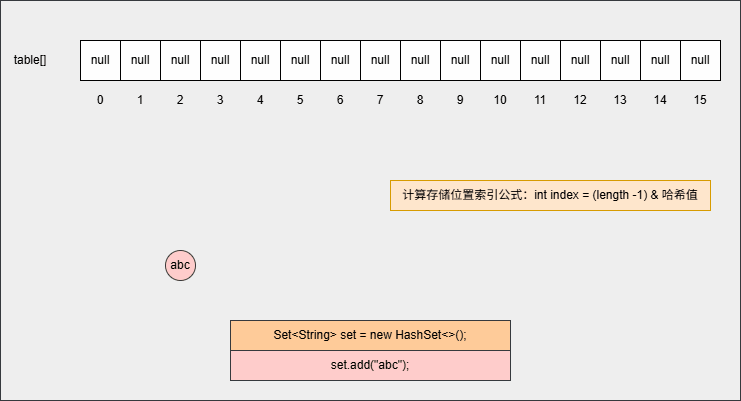
- ③ 为什么计算索引的公式是
int index = (length -1) & 哈希值?
txt
假设数组的长度是 16,那么 length - 1 = 15,其二进制是 0000 0000 0000 1111
如果对象的哈希值是 123456,其二进制就是 0011 0000 0011 1001
0000 0000 0000 1111
& 0011 0000 0011 1001
---------------------
0000 0000 0000 1001
而 0000 0000 0000 1001 对应的十进制是 9 ,正好在 0 - 15 之间,即:数组的索引范围
任意数据的二进制和 0000 0000 0000 1111 与的结果,都是保留低 4 位,恰好在数组索引范围1
2
3
4
5
6
7
8
9
10
2
3
4
5
6
7
8
9
10
- ④ 判断当前位置是否为 null ,如果是 null 直接存入。
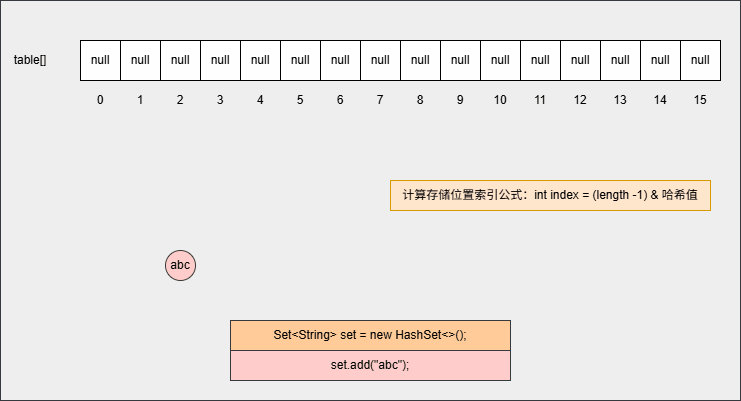
- ⑤ 此时,继续添加元素,如下所示:
java
set.add("bcd");1
- 其背后会重复 ②、③ 、④ 步骤,如下所示:

- ⑥ 此时,继续添加元素,如下所示:
java
set.add("bcd");
set.add("acD");1
2
2
- 其背后会重复 ②、③ 步骤,但是如果位置不是 null ,则表明该位置有元素,就需要调用 equals() 方法比较属性值。
提醒
- ① equals() 方法的结果:如果一样,直接丢弃。如果不一样,就存入到数组中,形成链表。
- ② 为什么还需要调用 equals() 方法来判断?因为有小概率情况会出现哈希碰撞,即:两个不同的对象其哈希值是相同的,如:
"abc"和"aCD",在这种情况下,就需要调用 equals() 方法比较其内部属性值。
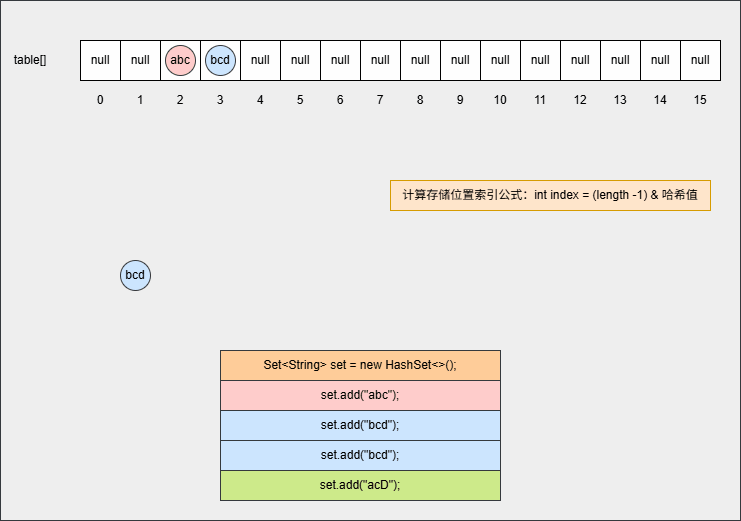
- ⑦ 如果位置不为 null,并且调用 equals() 方法比较属性值,其结果是 false ,JDK 各个版本的操作是不一样的:
提醒
- ① 调用 equals() 方法比较属性值,其结果是 false,表示要添加的元素和指定位置上的元素不一样。
- ② JDK8 之前:新元素添加到数组中,老元素挂在新元素的下面。

- ⑧ 如果位置不为 null,并且调用 equals() 方法比较属性值,其结果是 false ,JDK 各个版本的操作是不一样的:
提醒
- ① 调用 equals() 方法比较属性值,其结果是 false,表示要添加的元素和指定位置上的元素不一样。
- ② JDK8 之后:新元素直接挂到老元素下面。
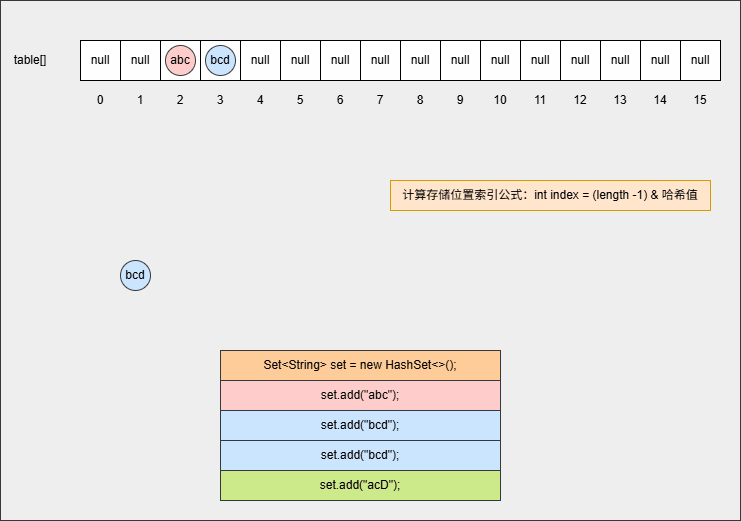
- ⑨ 此时,继续添加元素,如下所示:
java
set.add("bCc");
set.add("bDD");
set.add("abc");1
2
3
2
3
- 其背后会重复 ②、③ 步骤,但是如果位置不是 null ,则表明该位置有元素,就需要调用 equals() 方法比较属性值。
提醒
- ① equals() 方法的结果:如果一样,直接丢弃。如果不一样,就存入到数组中,形成链表。
- ② 为什么还需要调用 equals() 方法来判断?因为有小概率情况会出现哈希碰撞,即:两个不同的对象其哈希值是相同的,如:
"abc"和"aCD",在这种情况下,就需要调用 equals() 方法比较其内部属性值。
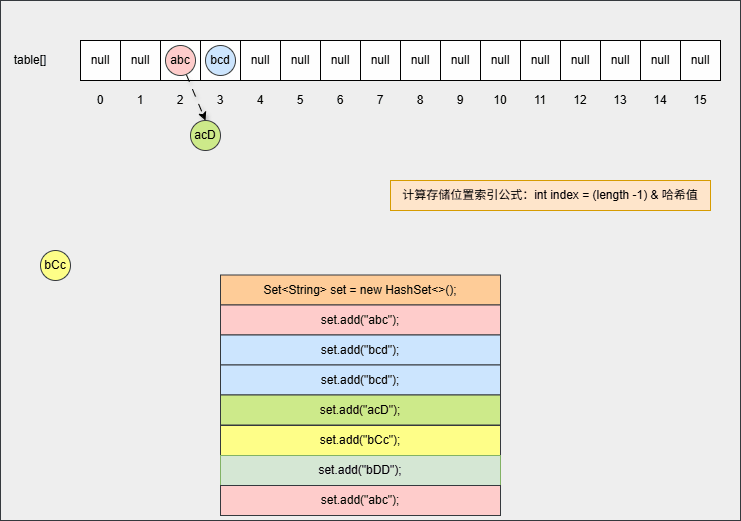
- ⑩ 此时,继续添加元素,如下所示:
java
set.add("???");
...
set.add("???");1
2
3
2
3
- 当数组中的元素的个数增加到
16 * 0.75 = 12,此时数组会扩容为原来的 2 倍,如下所示:
提醒
新数组的长度就是 16 * 2 = 32 。
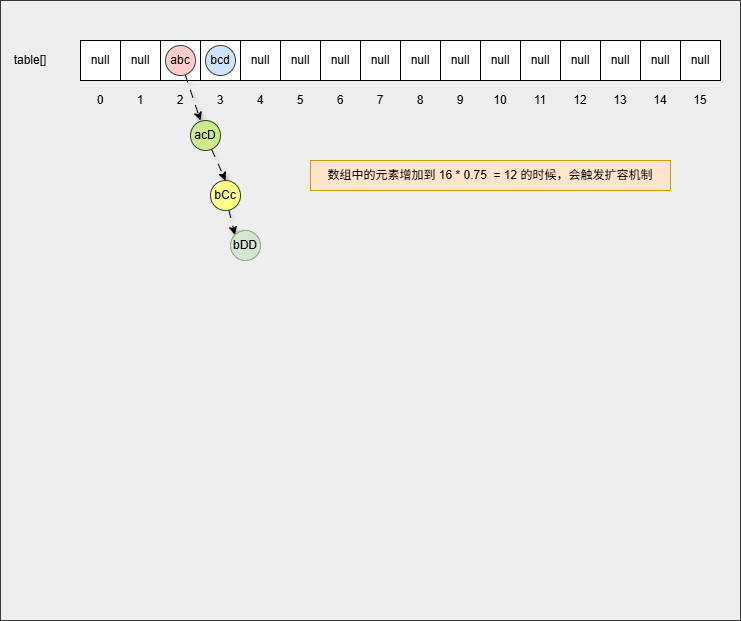
- ⑪ 但是,如果链表长度 > 8 并且数组长度 >= 64 时,链表就会自动转成红黑树,以便提高查找的效率。
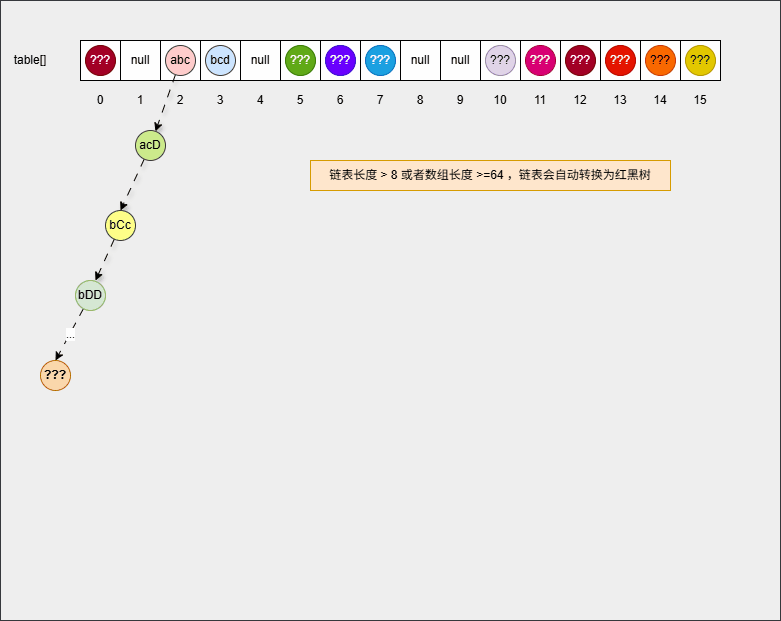
提醒
总结:
- ① 创建一个默认长度是 16,默认加载因子是 0.75 的数组,数组名是 table 。
- ② 根据元素的
哈希值和数组的长度计算出要存入的位置。 - ③ 判断当前位置是否为 null,如果是 null ,直接存入。
- ④ 判断当前位置是否为 null,如果不是 null,则表示当前位置有元素,就需要调用 equals 方法比较属性值。
- ⑤ 如果一样,则不存;如果不一样,就需要存入数组,形成链表。
- JDK8 之前,新元素存入到数组中,老元素挂在新元素下面。
- JDK8 之后,新元素直接挂在老元素下面。
- ⑥ 在 JDK8 之后,如果链表长度 > 8 并且数组长度 >= 64 时,链表就会自动转成红黑树,以便提高查找的效率。
- ⑦ 如果集合中存储的是自定义对象,必须重写 hashCode() 方法和 equals() 方法。
- ⑧ 如果 String、Integer 等 JDK 内置的引用数据类型,是不需要重写 hashCode() 方法和 equals() 方法(JDK 开发人员已经帮助我们重写好了)。
2.1.4 灵魂拷问
2.1.4.1 问题一
- 【问】HashSet 为什么存和取的顺序不一样?
- 【答】HashSet 存储数据的时候,是根据元素的 hashCode() 方法和 equals() 方法进行存储的,即:添加元素是不一定从数组 0 索引开始存储。

- 【答】HashSet 遍历数据的时候,是从数组的 0 索引开始的,一条链表一条链表地去遍历。
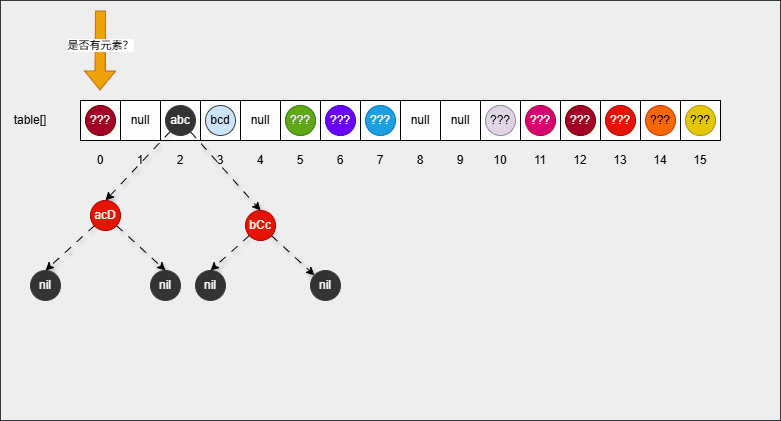
2.1.4.2 问题二
- 【问】HashSet 为什么没有索引?
- 【答】HashSet 的底层是
数组+链表+红黑树,那么如何定义谁是 0 索引,谁又是 1 索引?数组确实是有索引的;但是,数组相同索引处可能有多个元素(链表或红黑树),这么多元素共用一个索引,也不太合适,所以 HashSet 就取消了索引机制。
2.1.4.3 问题三
- 【问】HashSet 是利用什么机制来保证数据唯一,即:不重复?
- 【答】HashSet 是根据根据元素的 hashCode() 方法(获取哈希值,确定在数组中的存储位置)和 equals() 方法(判断对象内部的属性值是否相同)来保证数据唯一。
2.1.5 综合练习
- 需求:创建一个存储学生对象的集合,并存储多个学生对象,并在控制台遍历该集合。
提醒
如果学生对象的成员变量都相同,我们才认为是同一个学生。
- 示例:
java
package com.github.collection3;
import java.util.Objects;
public class Student {
private Integer id;
private String name;
private Integer age;
public Student(Integer id, String name, Integer age) {
this.id = id;
this.name = name;
this.age = age;
}
public Integer getId() {
return id;
}
public void setId(Integer id) {
this.id = id;
}
public String getName() {
return name;
}
public void setName(String name) {
this.name = name;
}
public Integer getAge() {
return age;
}
public void setAge(Integer age) {
this.age = age;
}
@Override
public boolean equals(Object o) {
if (o == null || getClass() != o.getClass()) return false;
Student student = (Student) o;
return Objects.equals(getId(), student.getId())
&& Objects.equals(getName(), student.getName())
&& Objects.equals(getAge(), student.getAge());
}
@Override
public int hashCode() {
return Objects.hash(getId(), getName(), getAge());
}
@Override
public String toString() {
return "Student{" +
"id=" + id +
", name='" + name + '\'' +
", age=" + age +
'}';
}
}1
2
3
4
5
6
7
8
9
10
11
12
13
14
15
16
17
18
19
20
21
22
23
24
25
26
27
28
29
30
31
32
33
34
35
36
37
38
39
40
41
42
43
44
45
46
47
48
49
50
51
52
53
54
55
56
57
58
59
60
61
62
2
3
4
5
6
7
8
9
10
11
12
13
14
15
16
17
18
19
20
21
22
23
24
25
26
27
28
29
30
31
32
33
34
35
36
37
38
39
40
41
42
43
44
45
46
47
48
49
50
51
52
53
54
55
56
57
58
59
60
61
62
java
package com.github.collection3;
import java.util.HashSet;
import java.util.Set;
public class Test {
public static void main(String[] args) {
Set<Student> set = new HashSet<>();
set.add(new Student(1, "张三", 18));
set.add(new Student(1, "张三", 18));
set.add(new Student(2, "李四", 19));
set.add(new Student(2, "李四", 20));
set.add(new Student(3, "王五", 19));
set.add(new Student(4, "赵六", 25));
set.add(new Student(5, "田七", 19));
set.add(new Student(6, "王八", 32));
set.forEach(System.out::println);
}
}1
2
3
4
5
6
7
8
9
10
11
12
13
14
15
16
17
18
19
20
21
22
23
2
3
4
5
6
7
8
9
10
11
12
13
14
15
16
17
18
19
20
21
22
23
txt
Student{id=5, name='田七', age=19}
Student{id=1, name='张三', age=18}
Student{id=2, name='李四', age=20}
Student{id=3, name='王五', age=19}
Student{id=2, name='李四', age=19}
Student{id=4, name='赵六', age=25}
Student{id=6, name='王八', age=32}1
2
3
4
5
6
7
2
3
4
5
6
7
2.2 LinkedHashSet
2.2.1 概述
- LinkedHashSet 是 HashSet 的子类,其常用 API 和 HashSet 相同。
- LinkedHashSet 的特点是:
有序,即:存取元素的顺序一致。不重复,即:集合中的元素不能重复(可以利用这个特性去除重复元素)。无索引,即:没有提供获取索引的方法(不能使用普通的 for 循环遍历,也不能通过索引来获取元素)。
- LinkedHashSet 底层原理:采取的是
哈希表来存储数据的,但是每个元素又额外维护了一个双链表的机制来记录存储的顺序。
提醒
- ① HashSet 是无序的,因为底层就只是哈希表,而哈希表决定了其存储元素和取出元素的顺序不一致。
- ② LinkedHashSet 是有序的,虽然底层也是采取哈希表,但是哈希表中的每个元素额外维护了一个双链表,用来记录存储的顺序。
2.2.2 底层原理
- ① 当我们创建一个 HashSet 集合对象的时候,如下所示:
java
Set<String> set = new LinkedHashSet<>();1
- 其背后会创建一个默认长度
16,默认加载因子0.75的数组,数组名是table,如下所示:
- ② 当我们向集合中添加元素的时候:
java
set.add("???");
...
set.add("???");1
2
3
4
5
2
3
4
5
- 其底层原理和 HashSet 相同,都会调用 hashCode() 方法计算出哈希值,然后通过
int index = (length -1) & 哈希值公式,计算出在数组中的存入位置,并判断指定位置是否有数据:如果没有,直接插入;如果有, 再调用 equals() 方法判断对象的内部属性值是否相同,如果相同,则不存入,如果不相同,则形成链表结构等,如下所示:
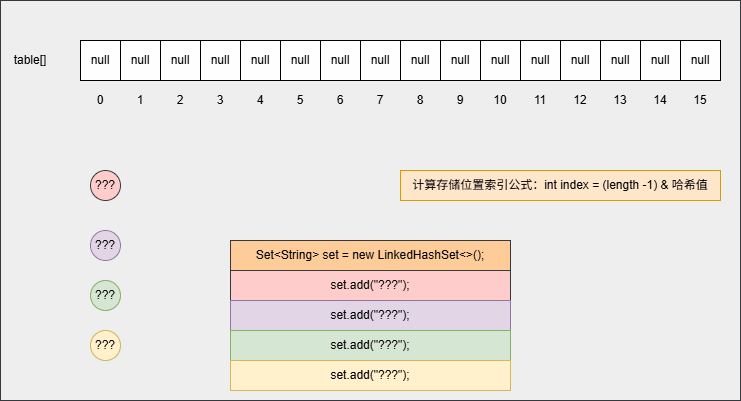
- 但是,在向集合中添加第一个元素的时候,其底层还会维护一个双向链表,如下所示:

- ③ 当我们打印集合或者遍历集合中元素的时候,如下所示:
java
set.forEach(System.out::println);1
- 如果是 HashSet ,需要从数组 0 索引处依次向后遍历;但是,对于 LinkedHashset 只需要遍历双向链表,即:从头节点开始依次遍历到尾节点,如下所示:
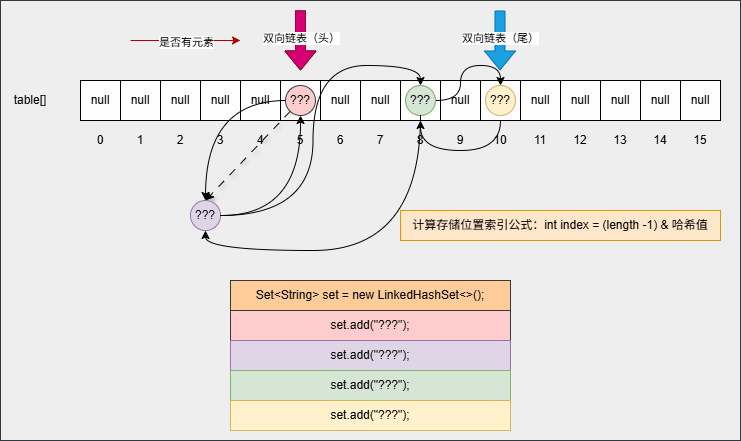
2.2.3 综合练习
- 需求:创建一个存储学生对象的集合,并存储多个学生对象,并在控制台遍历该集合。
提醒
如果学生对象的成员变量都相同,我们才认为是同一个学生。
- 示例:
java
package com.github.collection3;
import java.util.Objects;
public class Student {
private Integer id;
private String name;
private Integer age;
public Student(Integer id, String name, Integer age) {
this.id = id;
this.name = name;
this.age = age;
}
public Integer getId() {
return id;
}
public void setId(Integer id) {
this.id = id;
}
public String getName() {
return name;
}
public void setName(String name) {
this.name = name;
}
public Integer getAge() {
return age;
}
public void setAge(Integer age) {
this.age = age;
}
@Override
public boolean equals(Object o) {
if (o == null || getClass() != o.getClass()) return false;
Student student = (Student) o;
return Objects.equals(getId(), student.getId())
&& Objects.equals(getName(), student.getName())
&& Objects.equals(getAge(), student.getAge());
}
@Override
public int hashCode() {
return Objects.hash(getId(), getName(), getAge());
}
@Override
public String toString() {
return "Student{" +
"id=" + id +
", name='" + name + '\'' +
", age=" + age +
'}';
}
}1
2
3
4
5
6
7
8
9
10
11
12
13
14
15
16
17
18
19
20
21
22
23
24
25
26
27
28
29
30
31
32
33
34
35
36
37
38
39
40
41
42
43
44
45
46
47
48
49
50
51
52
53
54
55
56
57
58
59
60
61
62
2
3
4
5
6
7
8
9
10
11
12
13
14
15
16
17
18
19
20
21
22
23
24
25
26
27
28
29
30
31
32
33
34
35
36
37
38
39
40
41
42
43
44
45
46
47
48
49
50
51
52
53
54
55
56
57
58
59
60
61
62
java
package com.github.collection3;
import java.util.LinkedHashSet;
import java.util.Set;
public class Test {
public static void main(String[] args) {
Set<Student> set = new LinkedHashSet<>();
set.add(new Student(1, "张三", 18));
set.add(new Student(1, "张三", 18));
set.add(new Student(2, "李四", 19));
set.add(new Student(2, "李四", 20));
set.add(new Student(3, "王五", 19));
set.add(new Student(4, "赵六", 25));
set.add(new Student(5, "田七", 19));
set.add(new Student(6, "王八", 32));
set.forEach(System.out::println);
}
}1
2
3
4
5
6
7
8
9
10
11
12
13
14
15
16
17
18
19
20
21
22
23
2
3
4
5
6
7
8
9
10
11
12
13
14
15
16
17
18
19
20
21
22
23
txt
Student{id=1, name='张三', age=18}
Student{id=2, name='李四', age=19}
Student{id=2, name='李四', age=20}
Student{id=3, name='王五', age=19}
Student{id=4, name='赵六', age=25}
Student{id=5, name='田七', age=19}
Student{id=6, name='王八', age=32}1
2
3
4
5
6
7
2
3
4
5
6
7
2.3 总结
- HashSet 和 LinkedHashSet 的特点和原理,如下所示:
| Set 集合 | 特点 | 底层原理 |
|---|---|---|
| HashSet | 无序、不重复、无索引 | 底层基于哈希表 |
| LinkedHashSet | 有序、不重复、无索引 | 底层基于哈希表;但是,使用双链表记录添加顺序 |
- 在实际开发中,如果需要数据去重,如何选择?
- ① 默认情况下,选择 HashSet。
- ② 如果需要数据去重并且存取有序,就需要采用 LinkedHashSet 。
第三章:TreeSet(⭐)
3.1 概述
- TreeSet 和 HashSet 一样,都是 Set 接口实现类,其常用 API 和 HashSet 相同。
- TreeSet 的特点:
可排序,即:可以给元素进行排序。不重复,即:集合中的元素不能重复(可以利用这个特性去除重复元素)。无索引,即:没有提供获取索引的方法(不能使用普通的 for 循环遍历,也不能通过索引来获取元素)。
提醒
可排序指的是可以给 TreeSet 集合中的元素进行排序,默认是由小到大排序的。
- TreeSet 集合底层是基于
红黑树的数据结构实现排序的,增删改查性能都很好。
3.2 TreeSet 集合默认的排序规则
- ① 对于数值类型,如:Integer、Double 等,默认是按照从小到大的顺序进行排序的。
- ② 对于字符和字符串类型,如:Character、String 等,默认是按照字符在 ASCII 码表(Unicode 值)中的数字升序进行排序的。
提醒
- ① 如果是多个字符组成的字符串,和字符串的长度无关,会从首字母开始依次向后比。
- ② "qwer"、"cd"、"aaa"、"ab"、"aba" --> "aaa"、"ab"、"aba"、"cd"、"qwer"。
3.3 TreeSet 的排序方式
- 方式一:自然排序(默认排序):JavaBean 需要需要实现 Comparable 接口,并重写 compareTo() 抽象方法。
提醒
- ① TreeSet 会调用集合元素的 compareTo(Object obj) 方法来比较元素之间的大小关系,然后将集合元素按升序(默认情况)排列。
- ② 对于 JDK 很多内置的 JavaBean,JDK 的开发人员已经帮我们实现了 Comparable 接口,并重写 compareTo() 抽象方法。
| 类型 | 描述 |
|---|---|
| BigDecimal、Integer、Double 等 | 按照它们对应的数值大小进行比较。 |
| Character | 按照字符的 Unicode 值进行比较。 |
| Boolean | true 对应的包装类实例大于 false 对应的包装类实例。 |
| String | 按照字符串中字符的 Unicode 值进行比较。 |
| Date 等 | 后面的时间、日期比前面的时间、日期大。 |
- ③ 对于自定义引用数据类型(JavaBean ),必须手动实现 Comparable 接口,并重写 compareTo() 抽象方法。
- 方式二:自定义排序:创建 TreeSet 对象的时候,传递比较器 Comparator 指定规则。
提醒
TreeSet 会调用 Comparator 的 compare(T o1,T o2) 方法来进行元素之间的大小比较。
重要
默认使用第一种,如果第一种不能满足当前要求,就使用第二种!!!
3.4 底层红黑树演示
- ① 假设对应的代码,如下所示:
java
package com.github.collection3;
import java.util.Objects;
public class Student implements Comparable<Student> {
private Integer id;
private String name;
private Integer age;
public Student(Integer id, String name, Integer age) {
this.id = id;
this.name = name;
this.age = age;
}
public Integer getId() {
return id;
}
public void setId(Integer id) {
this.id = id;
}
public String getName() {
return name;
}
public void setName(String name) {
this.name = name;
}
public Integer getAge() {
return age;
}
public void setAge(Integer age) {
this.age = age;
}
@Override
public boolean equals(Object o) {
if (o == null || getClass() != o.getClass()) return false;
Student student = (Student) o;
return Objects.equals(getId(), student.getId())
&& Objects.equals(getName(), student.getName())
&& Objects.equals(getAge(), student.getAge());
}
@Override
public int hashCode() {
return Objects.hash(getId(), getName(), getAge());
}
@Override
public String toString() {
return "Student{" +
"id=" + id +
", name='" + name + '\'' +
", age=" + age +
'}';
}
/**
* 负数:认为要添加的元素是小的,存左边
* 正数:认为要添加的元素是大的,存右边
* 0 :认为要添加的元素已经存在,舍弃(也可以认为覆盖)
*/
@Override
public int compareTo(Student o) {
// this 是当前要添加的元素
// o 是已经在红黑树中存在的元素
return this.age - o.age;
}
}1
2
3
4
5
6
7
8
9
10
11
12
13
14
15
16
17
18
19
20
21
22
23
24
25
26
27
28
29
30
31
32
33
34
35
36
37
38
39
40
41
42
43
44
45
46
47
48
49
50
51
52
53
54
55
56
57
58
59
60
61
62
63
64
65
66
67
68
69
70
71
72
73
74
2
3
4
5
6
7
8
9
10
11
12
13
14
15
16
17
18
19
20
21
22
23
24
25
26
27
28
29
30
31
32
33
34
35
36
37
38
39
40
41
42
43
44
45
46
47
48
49
50
51
52
53
54
55
56
57
58
59
60
61
62
63
64
65
66
67
68
69
70
71
72
73
74
java
package com.github.collection3;
import java.util.Set;
import java.util.TreeSet;
public class Test {
public static void main(String[] args) {
// 创建三个学生对象
Student s1 = new Student(1, "zhangsan", 23);
Student s2 = new Student(2, "lisi", 24);
Student s3 = new Student(3, "wangwu", 25);
// 创建 Set 集合
Set<Student> set = new TreeSet<>();
// 向集合中添加元素
set.add(s3);
set.add(s2);
set.add(s1);
// 遍历集合
set.forEach(System.out::println);
}
}1
2
3
4
5
6
7
8
9
10
11
12
13
14
15
16
17
18
19
20
21
2
3
4
5
6
7
8
9
10
11
12
13
14
15
16
17
18
19
20
21
txt
Student{id=1, name='zhangsan', age=23}
Student{id=2, name='lisi', age=24}
Student{id=3, name='wangwu', age=25}1
2
3
2
3
- ② 当我们创建三个学生对象的时候,并创建集合对象的时候:
java
// 创建三个学生对象
Student s1 = new Student(1, "zhangsan", 23);
Student s2 = new Student(2, "lisi", 24);
Student s3 = new Student(3, "wangwu", 25);
// 创建 Set 集合
Set<Student> set = new TreeSet<>();1
2
3
4
5
6
2
3
4
5
6
- 其内存动态图,如下所示:
- ③ 当我们向集合对象中添加第一个元素,如下所示:
java
set.add(s3);1
- 其内存动态图,如下所示:
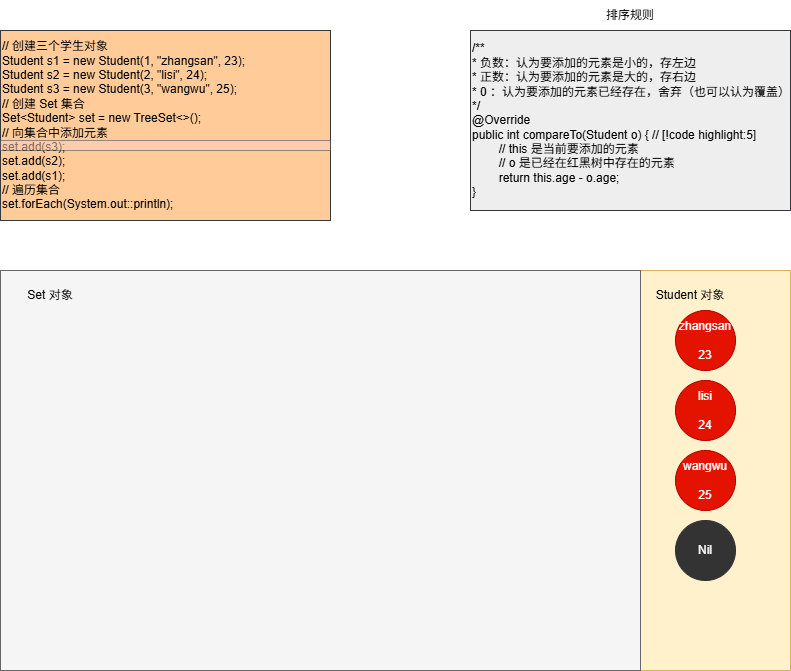
- ④ 当我们向集合中添加第二个元素,如下所示:
java
set.add(s2);1
- 其内存动态图,如下所示:
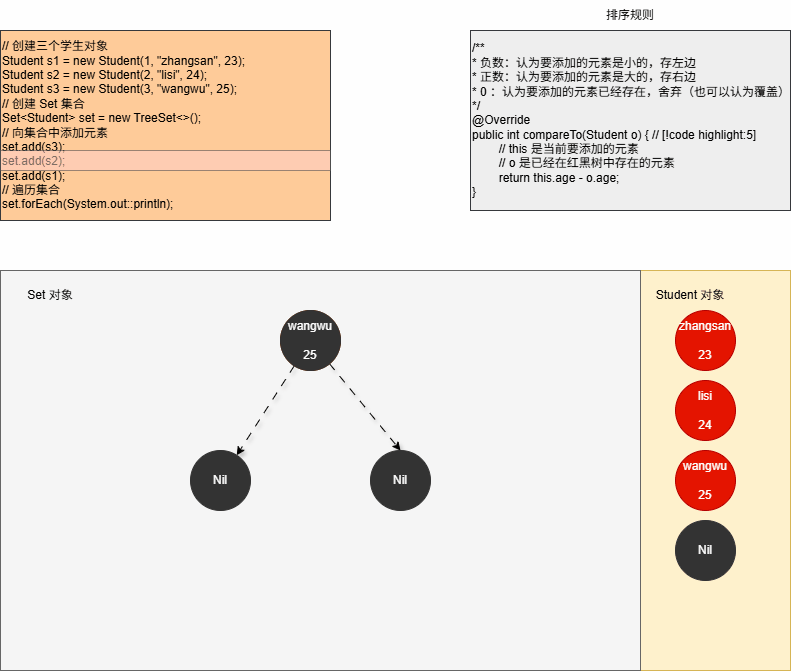
- ⑤ 当我们向集合中添加第三个元素,如下所示:
java
set.add(s1);1
- 其内存动态图,如下所示:
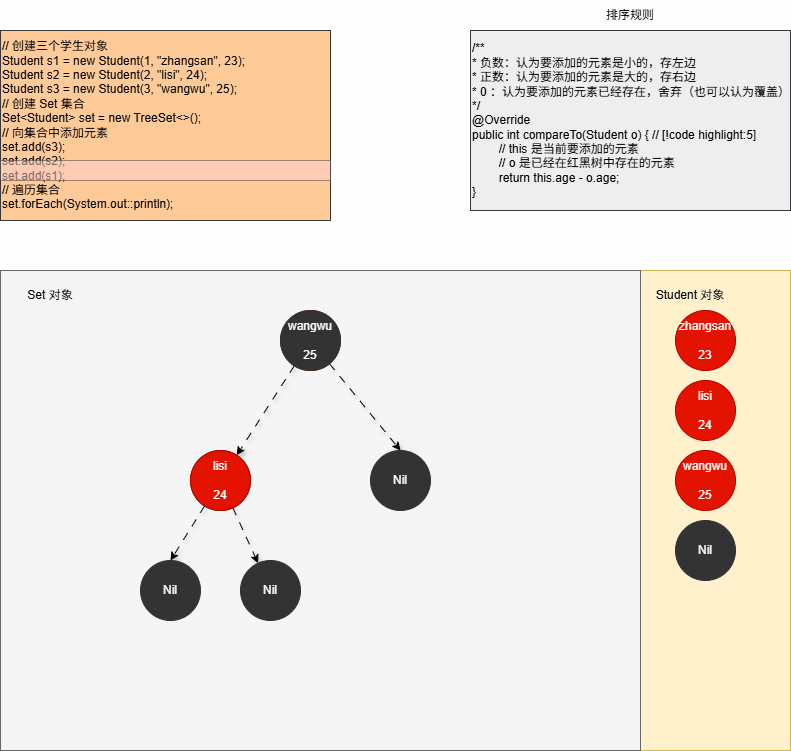
- ⑥ 修改 Student.java 中的 compareTo() 方法,增加日志来证明上述的推断,如下所示:
java
package com.github.collection3;
import java.util.Objects;
public class Student implements Comparable<Student> {
private Integer id;
private String name;
private Integer age;
public Student(Integer id, String name, Integer age) {
this.id = id;
this.name = name;
this.age = age;
}
public Integer getId() {
return id;
}
public void setId(Integer id) {
this.id = id;
}
public String getName() {
return name;
}
public void setName(String name) {
this.name = name;
}
public Integer getAge() {
return age;
}
public void setAge(Integer age) {
this.age = age;
}
@Override
public boolean equals(Object o) {
if (o == null || getClass() != o.getClass()) return false;
Student student = (Student) o;
return Objects.equals(getId(), student.getId())
&& Objects.equals(getName(), student.getName())
&& Objects.equals(getAge(), student.getAge());
}
@Override
public int hashCode() {
return Objects.hash(getId(), getName(), getAge());
}
@Override
public String toString() {
return "Student{" +
"id=" + id +
", name='" + name + '\'' +
", age=" + age +
'}';
}
@Override
public int compareTo(Student o) {
System.out.println("---------------- 开始 --------------- ");
System.out.println("this:" + this);
System.out.println("o:" + o);
System.out.println("---------------- 结束 --------------- ");
return this.age - o.age;
}
}1
2
3
4
5
6
7
8
9
10
11
12
13
14
15
16
17
18
19
20
21
22
23
24
25
26
27
28
29
30
31
32
33
34
35
36
37
38
39
40
41
42
43
44
45
46
47
48
49
50
51
52
53
54
55
56
57
58
59
60
61
62
63
64
65
66
67
68
69
70
71
2
3
4
5
6
7
8
9
10
11
12
13
14
15
16
17
18
19
20
21
22
23
24
25
26
27
28
29
30
31
32
33
34
35
36
37
38
39
40
41
42
43
44
45
46
47
48
49
50
51
52
53
54
55
56
57
58
59
60
61
62
63
64
65
66
67
68
69
70
71
java
package com.github.collection3;
import java.util.Set;
import java.util.TreeSet;
public class Test {
public static void main(String[] args) {
// 创建三个学生对象
Student s1 = new Student(1, "zhangsan", 23);
Student s2 = new Student(2, "lisi", 24);
Student s3 = new Student(3, "wangwu", 25);
// 创建 Set 集合
Set<Student> set = new TreeSet<>();
// 向集合中添加元素
set.add(s3);
set.add(s2);
set.add(s1);
// 遍历集合
set.forEach(System.out::println);
}
}1
2
3
4
5
6
7
8
9
10
11
12
13
14
15
16
17
18
19
20
21
2
3
4
5
6
7
8
9
10
11
12
13
14
15
16
17
18
19
20
21
txt
---------------- 开始 ---------------
this:Student{id=3, name='wangwu', age=25}
o:Student{id=3, name='wangwu', age=25}
---------------- 结束 ---------------
---------------- 开始 ---------------
this:Student{id=2, name='lisi', age=24}
o:Student{id=3, name='wangwu', age=25}
---------------- 结束 ---------------
---------------- 开始 ---------------
this:Student{id=1, name='zhangsan', age=23}
o:Student{id=3, name='wangwu', age=25}
---------------- 结束 ---------------
---------------- 开始 ---------------
this:Student{id=1, name='zhangsan', age=23}
o:Student{id=2, name='lisi', age=24}
---------------- 结束 ---------------
Student{id=1, name='zhangsan', age=23}
Student{id=2, name='lisi', age=24}
Student{id=3, name='wangwu', age=25}1
2
3
4
5
6
7
8
9
10
11
12
13
14
15
16
17
18
19
2
3
4
5
6
7
8
9
10
11
12
13
14
15
16
17
18
19
3.5 综合练习
需求:向 TreeSet 中存储整数并进行排序。
示例:
java
package com.github.collection3;
import java.util.Set;
import java.util.TreeSet;
public class Test {
public static void main(String[] args) {
Set<Integer> set = new TreeSet<>();
set.add(5);
set.add(4);
set.add(1);
set.add(3);
set.add(2);
set.forEach(System.out::println);
}
}1
2
3
4
5
6
7
8
9
10
11
12
13
14
15
16
17
18
19
2
3
4
5
6
7
8
9
10
11
12
13
14
15
16
17
18
19
txt
1
2
3
4
51
2
3
4
5
2
3
4
5
3.6 综合练习
- 需求:创建 TreeSet 集合对象,并添加 3 个学生对象。
提醒
- ① 学生对象属性:id、姓名、年龄。
- ② 要求按照学生的年龄进行排序,如果年龄相同则按照姓名进行排序。
- 示例:
java
package com.github.collection3;
import java.util.Objects;
public class Student implements Comparable<Student> {
private Integer id;
private String name;
private Integer age;
public Student(Integer id, String name, Integer age) {
this.id = id;
this.name = name;
this.age = age;
}
public Integer getId() {
return id;
}
public void setId(Integer id) {
this.id = id;
}
public String getName() {
return name;
}
public void setName(String name) {
this.name = name;
}
public Integer getAge() {
return age;
}
public void setAge(Integer age) {
this.age = age;
}
@Override
public boolean equals(Object o) {
if (o == null || getClass() != o.getClass()) return false;
Student student = (Student) o;
return Objects.equals(getId(), student.getId())
&& Objects.equals(getName(), student.getName())
&& Objects.equals(getAge(), student.getAge());
}
@Override
public int hashCode() {
return Objects.hash(getId(), getName(), getAge());
}
@Override
public String toString() {
return "Student{" +
"id=" + id +
", name='" + name + '\'' +
", age=" + age +
'}';
}
@Override
public int compareTo(Student o) {
return !this.age.equals(o.age)
? Integer.compare(this.age, o.age)
: this.name.compareTo(o.name);
}
}1
2
3
4
5
6
7
8
9
10
11
12
13
14
15
16
17
18
19
20
21
22
23
24
25
26
27
28
29
30
31
32
33
34
35
36
37
38
39
40
41
42
43
44
45
46
47
48
49
50
51
52
53
54
55
56
57
58
59
60
61
62
63
64
65
66
67
68
69
2
3
4
5
6
7
8
9
10
11
12
13
14
15
16
17
18
19
20
21
22
23
24
25
26
27
28
29
30
31
32
33
34
35
36
37
38
39
40
41
42
43
44
45
46
47
48
49
50
51
52
53
54
55
56
57
58
59
60
61
62
63
64
65
66
67
68
69
java
package com.github.collection3;
import java.util.Set;
import java.util.TreeSet;
public class Test {
public static void main(String[] args) {
Set<Student> set = new TreeSet<>();
Student s1 = new Student(1, "张三", 18);
Student s2 = new Student(2, "李四", 36);
Student s3 = new Student(3, "王五", 35);
Student s4 = new Student(4, "赵六", 24);
Student s5 = new Student(5, "田七", 40);
Student s6 = new Student(6, "王八", 18);
set.add(s1);
set.add(s2);
set.add(s3);
set.add(s4);
set.add(s5);
set.add(s6);
set.forEach(System.out::println);
}
}1
2
3
4
5
6
7
8
9
10
11
12
13
14
15
16
17
18
19
20
21
22
23
24
25
26
2
3
4
5
6
7
8
9
10
11
12
13
14
15
16
17
18
19
20
21
22
23
24
25
26
txt
Student{id=1, name='张三', age=18}
Student{id=6, name='王八', age=18}
Student{id=4, name='赵六', age=24}
Student{id=3, name='王五', age=35}
Student{id=2, name='李四', age=36}
Student{id=5, name='田七', age=40}1
2
3
4
5
6
2
3
4
5
6
3.7 综合练习
- 需求:创建 TreeSet 对象,向其中存入
"c"、"ab"、"df"、"qwer"。
提醒
- ① 默认按照长度进行排序,如果一样长,则按照首字母进行排序。
- ② 最好采用自定义排序,因为我们没有办法去修改 String 内部的源码,进行去修改其内部的规则。
- 示例:
java
package com.github.collection3;
import java.util.Set;
import java.util.TreeSet;
public class Test {
public static void main(String[] args) {
Set<String> set = new TreeSet<>((s1, s2) -> {
int result = s1.length() - s2.length();
if (result == 0) {
return s1.compareTo(s2);
}
return result;
});
set.add("c");
set.add("ab");
set.add("df");
set.add("qwer");
set.forEach(System.out::println);
}
}1
2
3
4
5
6
7
8
9
10
11
12
13
14
15
16
17
18
19
20
21
22
23
24
25
26
2
3
4
5
6
7
8
9
10
11
12
13
14
15
16
17
18
19
20
21
22
23
24
25
26
txt
c
ab
df
qwer1
2
3
4
2
3
4
3.8 总结
- TreeSet 的特点和原理,如下所示:
| Set 集合 | 特点 | 底层原理 |
|---|---|---|
| TreeSet | 可排序、不重复、无索引 | 底层基于红黑树进行排序,增删改查性能好 |
TreeSet 的自定义排序有几种方式?
- ① 默认排序(自然排序):Javabean 类实现 Comparable 接口,指定比较规则。
- ② 自定义排序:创建集合时,自定义 Comparator 比较器对象,指定比较规则。
方法返回值的特点:
- ① 负数:表示当前要添加的元素是小的,存左边。
- ② 正数:表示当前要添加的元素是大的,存右边。
- ③ 0:表示当期要添加的元素已经存在,舍弃(覆盖)。
3.9 实际开发,如何选择?
- ① 如果想要集合中的元素是
可重复的?
提醒
请使用 ArrayList 集合,基于数组(使用最多)。
- ② 如果想要集合中的元素是
可重复的,而且增删操作明显多于查询?
提醒
请使用 LinkedList 集合,基于链表。
- ③ 如果想要对集合元素
去重(去除重复元素,保证集合中元素唯一)?
提醒
请使用 HashSet 集合,基于哈希表(使用最多)。
- ④ 如果想要对集合元素
去重,并且保证存取顺序?
提醒
请使用 LinkedHashSet 集合,基于哈希表和双向链表,效率低于 HashSet。
- ⑤ 如果相对集合中的元素进行
排序:
提醒
- ① 请使用 TreeSet 集合,基于红黑树。
- ② 也可以使用 List 集合实现排序(jdk8+ 新增
sort(Comparator<? super E> c)方法)。
第四章:源码分析
4.1 概述
- HashSet、LinkedHashSet 以及 TreeSet 的底层实现都是 Map 集合。
- 如果想要研究源码,还需要先学习 Map 集合。
4.2 HashSet
- 我们可以查看 HashSet 的源码,如下所示:
java
public class HashSet<E>
extends AbstractSet<E>
implements Set<E>, Cloneable, java.io.Serializable {
private transient HashMap<E,Object> map;
public HashSet() {
map = new HashMap<>();
}
public HashSet(Collection<? extends E> c) {
map = new HashMap<>(Math.max((int) (c.size()/.75f) + 1, 16));
addAll(c);
}
...
}1
2
3
4
5
6
7
8
9
10
11
12
13
14
15
16
17
18
2
3
4
5
6
7
8
9
10
11
12
13
14
15
16
17
18
4.3 LinkedHashSet
- 我们可以查看 LinkedHashSet 的源码,如下所示:
java
public class LinkedHashSet<E>
extends HashSet<E>
implements Set<E>, Cloneable, java.io.Serializable {
public LinkedHashSet() {
super(16, .75f, true);
}
...
}1
2
3
4
5
6
7
8
9
10
11
2
3
4
5
6
7
8
9
10
11
java
public class HashSet<E>
extends AbstractSet<E>
implements Set<E>, Cloneable, java.io.Serializable {
HashSet(int initialCapacity, float loadFactor, boolean dummy) {
map = new LinkedHashMap<>(initialCapacity, loadFactor);
}
...
}1
2
3
4
5
6
7
8
9
10
11
2
3
4
5
6
7
8
9
10
11
4.4 TreeSet
- 我们可以查看 TreeSet 的源码,如下所示:
java
public class TreeSet<E> extends AbstractSet<E>
implements NavigableSet<E>, Cloneable, java.io.Serializable {
public TreeSet() {
this(new TreeMap<>());
}
...
}1
2
3
4
5
6
7
8
9
2
3
4
5
6
7
8
9